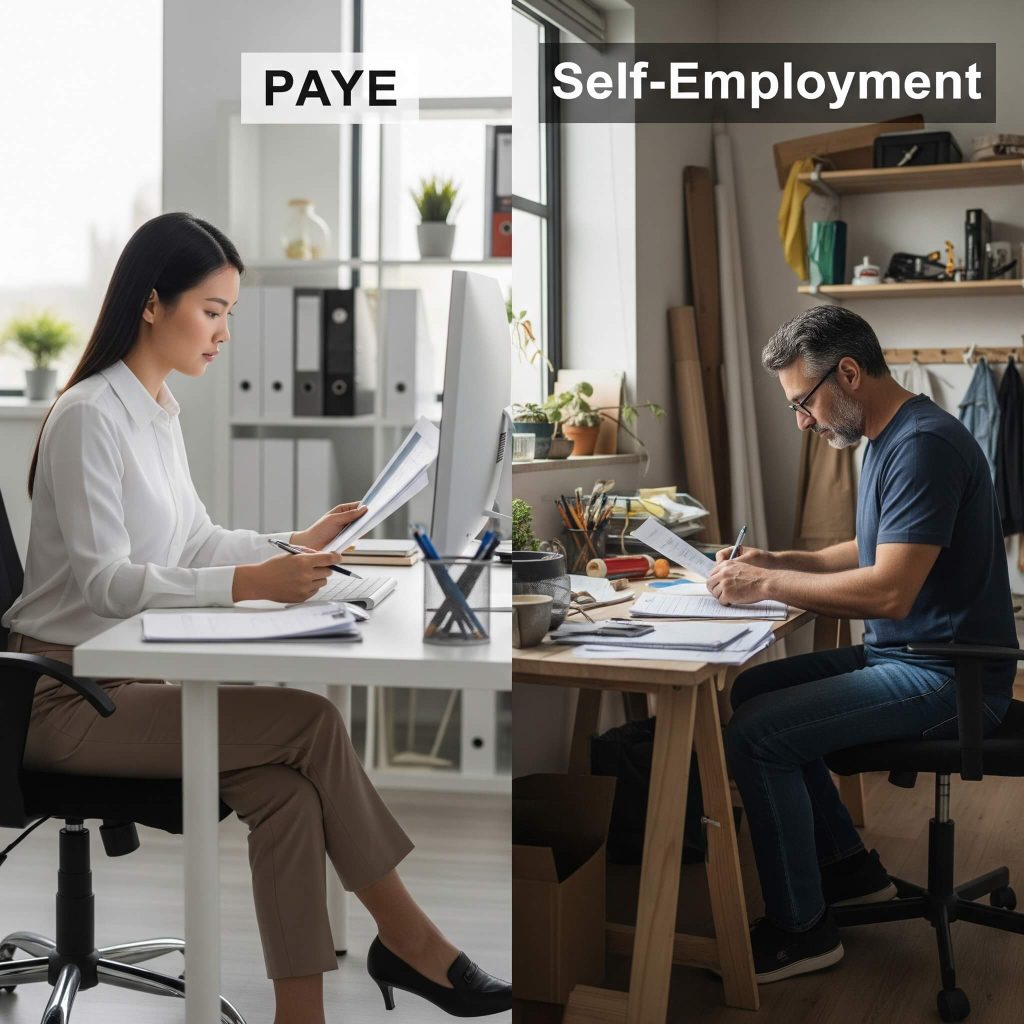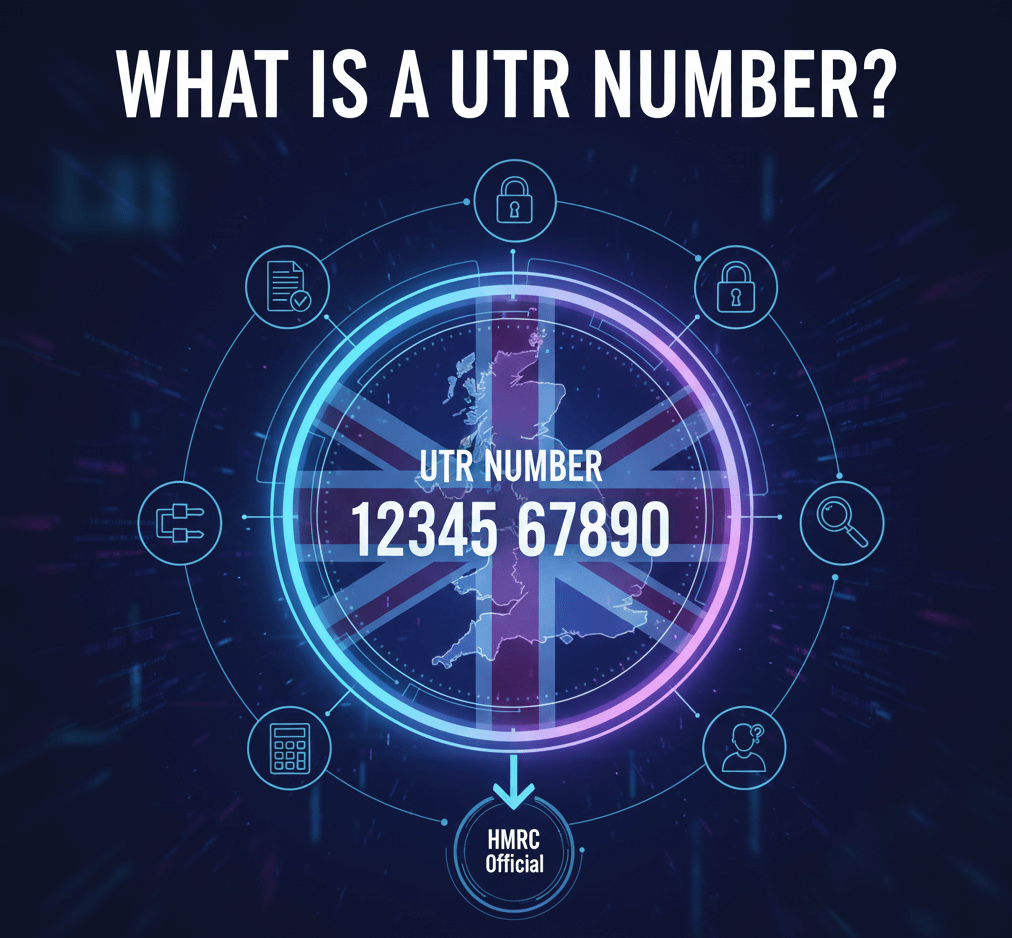Over 4.5 million people in the UK are self-employed — a number that has doubled in the last two decades.
Have you ever wondered whether working as a PAYE employee or going self-employed is the best choice for your career and lifestyle? Granted, there are cases where you may have no choice based on the status determination from the client.
However, choosing between PAYE and self-employment is more than just a tax decision — it shapes your financial security, work-life balance, and even your legal rights.
As industry experts with nearly 30 years’ experience supporting contractors and businesses, Futurelink Group understands the complexities involved in this choice.
Introduction
When it comes to working in the UK, two common routes dominate: PAYE (Pay As You Earn) employment and self-employment. The equivalent options are considered in all countries, and in some tax jurisdictions, being employed can be high inefficient, where take home pay can be poor.
Each offers distinct advantages and challenges that can significantly impact your professional journey and personal life. PAYE employment provides the stability of a regular salary, with taxes and National Insurance contributions automatically deducted by your employer. It often comes with employee benefits such as paid holidays, sick pay, and pension contributions.
On the other hand, self-employment offers greater flexibility and control over your work, allowing you to choose your clients and projects. However, it also means taking on the responsibility of managing your own tax affairs, National Insurance, and business expenses, without the safety net of employee benefits.
Understanding the key differences between PAYE and self-employment is crucial to making an informed decision that aligns with your financial goals, lifestyle preferences, and legal obligations. In this guide, we will explore the pros and cons of each option, helping you navigate this important choice with confidence.
What is PAYE Employment?
The Pay As You Earn (PAYE) system is the method used by HM Revenue & Customs (HMRC) to collect income tax and National Insurance contributions directly from employees’ wages before they are paid out. Under PAYE, your employer deducts these amounts automatically from your salary and passes them on to HMRC on your behalf.
This system means you receive a regular net salary, with tax and National Insurance already handled, allowing you to focus on your work without worrying about managing these deductions yourself. Employers also take care of other administrative duties such as pension contributions, statutory sick pay, and maternity or paternity pay.
One of the key benefits of PAYE employment is the range of statutory employee rights and benefits you receive. These include paid holidays, sick leave, pension contributions, and often access to workplace health insurance or other perks. Additionally, working as a PAYE employee often provides the opportunity to progress within an established career structure, offering stability and the chance to climb the career ladder.
The simplicity of PAYE is one of its biggest advantages — taxes are deducted at source, so you don’t need to file a tax return unless you have additional income or complex tax affairs. This makes financial planning more straightforward, with a steady, predictable income.
However, PAYE employment can come with less flexibility. Your working hours and projects are generally set by your employer, which may limit your ability to choose when and how you work. Salaries are often capped, and pay rises or promotions may take time to materialise. As an employee, you might also have less control over your work environment and the way tasks are completed.
What is Self-Employment?
Self-employment means running your own business or working as a sole trader, where you invoice clients directly and manage your own tax affairs. Unlike PAYE employees, self-employed individuals are responsible for calculating and paying their own income tax and National Insurance contributions via the Self Assessment system.
Self-employed workers pay income tax on their profits and must also pay both Class 2 and Class 4 National Insurance contributions. Class 2 is a flat weekly rate, while Class 4 is calculated as a percentage of profits above a certain threshold.
There are no automatic employee benefits when you are self-employed. You bear full responsibility for the success or failure of your business, including arranging your own insurance, pension, and managing any business expenses. This independence offers significant flexibility — you can choose your clients, projects, and working hours, tailoring your work to suit your lifestyle.
Self-employment also offers the potential to earn more, as your income is directly linked to your effort and business growth. You have the freedom to innovate, diversify your services, and scale your business as you see fit.
However, this freedom comes with risks. Income can be inconsistent, and you must handle all administrative tasks, including bookkeeping, invoicing, tax filing, and compliance with legal requirements. There is no safety net of statutory employment benefits, so financial planning and risk management are essential.

Key Differences Between PAYE and Self-Employment
Aspect | PAYE Employee | Self-Employed Contractor |
Tax Handling | Employer deducts tax and National Insurance | Individual files Self Assessment tax return and pays NIC |
Income Stability | Regular salary | Income can be irregular and variable |
Benefits | Paid holidays, sick pay, pension, statutory rights | No employee benefits; must arrange own insurance and pension |
Flexibility | Set working hours, employer controls work | Choose clients, projects, and working hours |
Administrative Burden | Minimal tax paperwork | Responsible for bookkeeping, invoicing, tax filing |
Legal Status | Employee with employment rights | Runs own business, lacks employee rights |
Expenses | Limited allowable expenses | Can claim allowable business expenses to reduce taxable profit |
Taxation Differences
As a self-employed individual, you are responsible for calculating and paying your own taxes. You pay income tax based on your trading profits, with profits over £50,271 taxed at 40%. You also make National Insurance contributions: Class 2 at a flat weekly rate, and Class 4 as a percentage of profits above a threshold.
In contrast, PAYE employees have their income tax and National Insurance automatically deducted by their employer, simplifying the process and reducing the risk of errors. This means you generally do not need to file a tax return unless you have additional income outside PAYE.
It is worth noting that income earned through self-employment or running your own company is often taxed at lower effective rates than employment income, particularly due to allowable business expenses, which can reduce taxable profits.
Advantages and Disadvantages
PAYE Advantages
- Regular income and financial predictability. PAYE employees receive a steady, reliable salary which makes budgeting and financial planning straightforward.
- Taxes and National Insurance are handled by the employer. This reduces administrative burden and minimises the risk of errors or missed payments.
- Access to employment benefits and protections. These typically include paid holidays, sick pay, pension contributions, and statutory rights such as maternity/paternity leave.
- Less administrative responsibility. Employees do not need to worry about bookkeeping, invoicing, or filing tax returns (unless they have additional income).
PAYE Disadvantages
- Less flexibility in working hours and choice of projects. Employers generally set your schedule and work assignments, which can limit personal freedom.
- Limited income growth potential. Salaries are often capped, and pay rises or promotions may depend on company policies and performance reviews.
- Reduced control over the work environment. Employees may have little say in how tasks are executed or the overall direction of their role.
Self-Employment Advantages
- Greater control over work schedule and client selection. You decide when, where, and for whom you work, allowing better alignment with your lifestyle.
- Potential to earn more based on effort and business growth. Unlike fixed salaries, your income can increase with your workload and success.
- Freedom to run your own business. This includes making strategic decisions and developing your brand or services.
- Ability to claim allowable business expenses. This can significantly reduce your taxable profits and overall tax bill.
Self-Employment Disadvantages
- Income can be inconsistent. Workloads may fluctuate, leading to periods of low or no income.
- You must manage taxes, National Insurance, and business expenses. This requires good financial organisation and discipline.
- Lack of statutory employment benefits or protections. You are responsible for arranging your own insurance, pension, and sick pay.
- Greater administrative burden. Bookkeeping, invoicing, and compliance with tax laws fall entirely on your shoulders.
Factors to Consider When Choosing
- Preference for stability versus flexibility. Do you value a predictable income and routine, or do you prioritise autonomy and varied work?
- Willingness to handle administrative and tax responsibilities. Are you comfortable managing your own finances and compliance, or would you rather have this handled for you?
- Desire for employment benefits and protections. Consider how important paid leave, pension contributions, and statutory rights are to you.
- Financial goals and risk tolerance. Self-employment can offer higher earnings but comes with financial uncertainty.
- Understanding your employment status is crucial. Misclassification can lead to significant tax liabilities and legal issues.
- Use HMRC’s employment status checker. This tool helps determine whether a worker should be classed as employed or self-employed, ensuring correct tax treatment.
Conclusion
Choosing between PAYE employment and self-employment is a pivotal decision that can shape your career, finances, and lifestyle for years to come. Both options offer unique advantages and present distinct challenges—while PAYE provides stability, simplicity, and a suite of employee benefits, self-employment offers autonomy, flexibility, and the potential for greater earnings.
Ultimately, the right path depends on your personal circumstances, professional ambitions, and appetite for risk and responsibility. By understanding the key differences and carefully weighing the pros and cons, you can make an informed decision that best supports your goals.
If you’re still unsure or want tailored advice, seeking expert guidance can help you navigate this important choice with confidence.
Take the Next Step with Futurelink Group
Ready to make your move or need more clarity?
At Futurelink Group, we’ve spent nearly three decades helping professionals like you find the payroll solution that fits their needs—whether you’re considering PAYE, self-employment, or something in between. Our award-winning team offers personalised support, compliance peace of mind, and a range of flexible solutions designed to help you thrive.
Explore your options, calculate your potential income, or get in touch for expert guidance today.

Craig Moss
Craig Moss is a seasoned professional in the employment and recruitment industries, based in Kings Langley, UK. With over 30 years of experience, including a successful tenure as a central London realtor handling properties up to £3 million, he now leads an exciting management role at Futurelink Group. Specialising in compliant payroll solutions for contract recruitment, Craig helps clients increase margins by up to 30% while navigating complex legislation. His people-focused approach, honed through decades in sales and people management, ensures both recruiters and workers benefit from tax-efficient, compliant solutions. Passionate about building strong relationships, Craig thrives on delivering results that drive business success.



